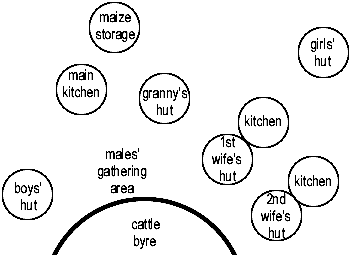|
The nucleus of a traditional Swazi homestead is granny's hut (kagogo), around which the life of the homestead revolves.The cattle byre (sibaya) is also an integral and important part of the homestead. These two structures hold the spiritual core of the homestead.

Adjacent to the granny's hut is the main kitchen (edladleni) which is also where the females of the homestead will converge in the early evening. Knowledge is shared with the young girls - this is where they will learn the facts of life and the implications of being a woman.
There is a semi-enclosed area where all the males of the family will gather at the same time of day (esangweni). The father will conduct proceedings - this is where the boys learn everything about being a man - the moral implications, the do's and don'ts, sex education, etc. The boys will never go into the women's area (edladleni), and the girls will never go into the men's area (ensangweni).
There is a separate hut for the girls (endzangeni), and on the opposite side of the homestead, one for the boys.
Adjacent to granny's hut (kagogo) is the first wife's hut and her kitchen. Then, extending in an arc from that will be the other wives' huts, each with it's own kitchen. The traditional structures are "beehive" huts.
The most common change from the traditional lifestyle in modern Swaziland is the change from "beehive" huts to rectangular "wattle and daub" rooms with corrugated iron roofing, with a similar change to the maize storage facilities.
|
